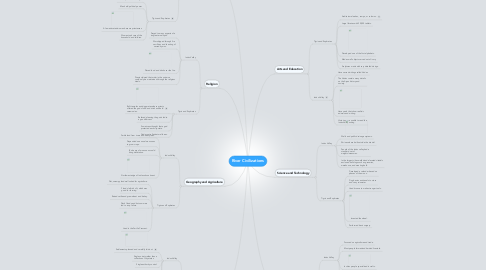
1. Government and Leaders
1.1. Indus Valley
1.1.1. Settlements planned and carefully laid out.
1.1.2. Single society rather than a collection of city-states.
1.1.3. Single authority control.
1.1.4. Groups of villages banded together under regional leaders,know as rajas.
1.1.5. Had religious leaders.
1.2. Tigris and Euphrates
1.2.1. Priests held high status in Sumerican city-states.
1.2.2. Kings ruled through local leaders.
1.2.3. Raised troops for an army.
1.2.4. Collected taxes and enforced laws.
2. Geography and Agriculture
2.1. Indus Valley
2.1.1. Fertile land from rivers and heavy rains.
2.1.2. Depended on annual monsoons to grow crops.
2.1.3. Too heavy of monsoons could bring devistation.
2.1.4. Northwest edge of India subcontinent.
2.2. Tigris and Euphrates
2.2.1. Flat, swampy land well suited for agriculture.
2.2.2. Floods left rich silt, which was good for farming.
2.2.3. Raised cattle and grew wheat and barley.
2.2.4. Flash floods and hot summers led to crop failure.
2.2.5. Lived in the Fertile Crescent.
3. Religion
3.1. Indus Valley
3.1.1. Prayed to many aspects of a single eternal spirit.
3.1.2. Worshipped through fire sacrifices and chanting of sacred hymns.
3.1.3. Placed food and drink over the fire.
3.1.4. Priests claimed that order in the universe could only be maintained through the religious rituals.
3.2. Tigris and Euphrates
3.2.1. Built temples and ziggurates where priests offered the gods food and drink and held ceremonies.
3.2.2. Believed pleasing the gods led to a good harvest.
3.2.3. Sumericans thought that a god protected each city-state.
3.2.4. Gods controlled natural forces.
4. Social Structure and Family
4.1. Indus Valley
4.1.1. Society was divided into four social classes called Varnas.
4.1.2. Varnas are divided into smaller caste systems.
4.1.3. A social hierarchy developed in which some castes had more privileges than others.
4.1.4. Untouchables belonged to no caste system and did jobs castes did not like handling dead animals.
4.2. Tigris and Euphrates
4.2.1. Developed social rankings.
4.2.2. Men held political power.
4.2.3. A few educated women became priestesses.
4.2.4. Women took care of the household and children.
5. Arts and Education
5.1. Tigris and Euphrates
5.1.1. Architectural arches, ramps, or columns.
5.1.2. Large libraries with 20,000 tablets.
5.1.3. Developed one of the first alphabets.
5.1.4. Made small objects carved out of ivory.
5.1.5. Sculptures made with very detailed design.
5.2. Indus Valley
5.2.1. Have sacred writings called Vedas.
5.2.2. The Vedas contain many details on the Aryan history and society.
5.2.3. Have seals that show realistic animals and writing.
5.2.4. Historians are unable to read the Indus Valley writing.
6. Science and Technology
6.1. Indus Valley
6.1.1. Wells and public drainage systems.
6.1.2. Shrines where built outside the citadel.
6.1.3. People of the Indus valley had a standard set of weights/measures.
6.1.4. In the largest cities walled and elevated citadels enclosed buildings such as granaries, warehouse, and meeting halls.
6.2. Tigris and Euphrates
6.2.1. Developed a calender based on phases of the moon.
6.2.2. Dug basins and canals to store and carry rainwater.
6.2.3. Used bronze to make stronger tools.
6.2.4. Invented the wheel.
6.2.5. Performed basic surgery.
7. Economy and Trade
7.1. Indus Valley
7.1.1. Focused on agriculture and trade.
7.1.2. Most people farmed and herded livestock.
7.1.3. In cities people specialized in crafts.
7.1.4. Traded with distant civilizations.
7.2. Tigris and Euprhates
7.2.1. Exchanges woven textiles.
7.2.2. Lived along a trade route.
7.2.3. Were a wealthy trading society.
7.2.4. Successful trading city-state as a result of where they lived.
